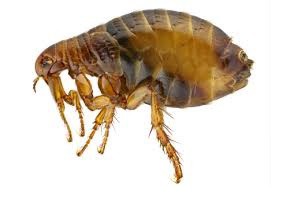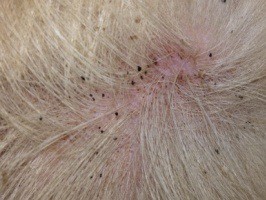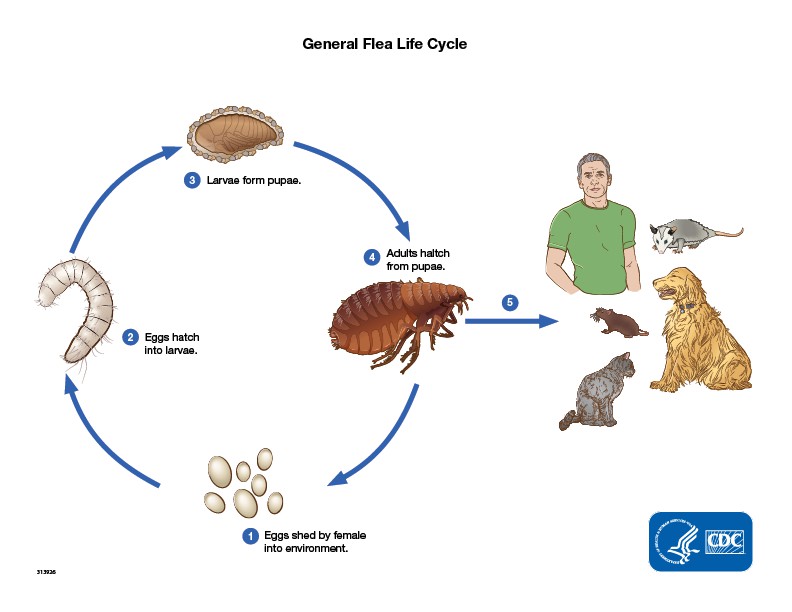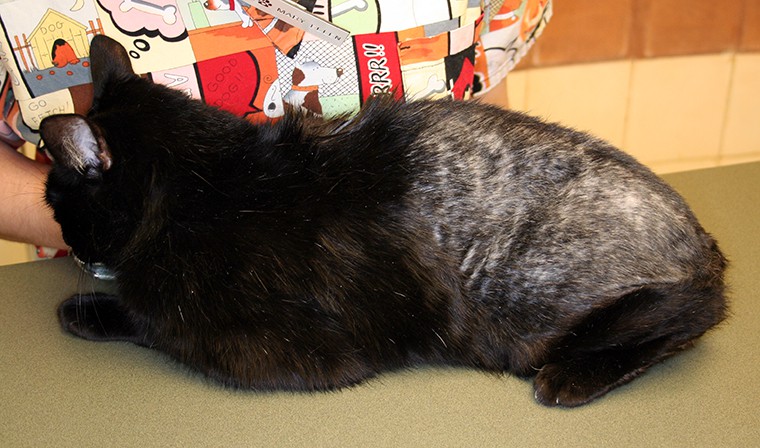Fleas are classified as ‘ecto parasites’ – meaning they live on the outside of a host, unlike the heartworm and intestinal worms as previously discussed. Similarly to their tick cousins, they can also be carriers for diseases such as flea allergy dermatitis, tapeworm, cat scratch fever and anaemia. Diagnosis is typically fairly straightforward – visualisation of the flea itself or flea dirt and any concurrent disease is usually enough diagnostic evidence to begin treatment.
What does a flea look like?
Only adult fleas can be visualised by the naked eye. They are extremely tiny (about 2-4mm in length), but not microscopic, and generally easier to notice when a significant flea burden is present.
If the flea is alive, then it will be crawling through the coat of your pet… and sometimes even jumping around too! But not seeing an adult flea does not necessarily mean your pet doesn’t have them… an adult flea only makes up about 5% of the flea population on a host – to which the eggs, larvae and pupae stages are invisible to us.

Figure 1: The flea (Best Care Animal Hospital, 2020)
Flea Dirt
Evidence of fleas can also be in the presence of flea dirt, which is a granule-type substance found on the skin of dogs and cats – resembling dirt. It consists of a mixture of flea faeces, and digested blood/waste product from the parasite. To determine whether the dirt on your pet’s coat is from fleas or not, scratch some of the dirt onto a white tissue. Lightly wet the tissue. If it leaks a red colour, then it is flea dirt.

Figure 2: Flea dirt (Best Care Animal Hospital, 2020)
Life Cycle
The flea has a very typical life cycle, but can vary in length of time. Depending on environmental conditions, they can be a short as 2-3 weeks, or last months (even years!). See Figure 3. for a visual representation.
In short, the fleas jump onto your pet, feed on their blood and start laying eggs. The eggs fall off the animal and drop into the carpet/bedding where they mature into larvae, then pupae, and then into adults, where they will jump onto your pet and the cycle repeats.
The adult flea is the only stage where it spends time on the host itself – and this is why its so difficult to get rid of fleas once an infestation has begun. Not only do you need to treat your pet for fleas, but the household as well!

Figure 3: Flea life cycle (CDC, 2020)
Flea infestation symptoms / diagnosis
There is no official diagnostic test to confirm or deny a flea burden. It is generally based on visual confirmation and concurrent symptoms as listed below – especially if you are not up to date with providing flea prevention to your pet.
Common symptoms of flea infestation include:
- Itching, scratching, licking, biting, chewing
- Hair loss – especially at the base of the tail
- Scabs
- Anaemia
- Lethargy
- Pale gums
Why are fleas so dangerous? Flea-borne diseases
Similarly to ticks, fleas can be a carrier for other diseases that can be transmitted to dogs and cats.
Flea allergy dermatitis – There can be residual skin problems such as erythema (redness) and alopecia (hair loss) even when a flea infestation seems to be otherwise eradicated. Your pet can have allergies to the protein in flea saliva that causes ongoing severe skin irritation that can flare up and last for months after the flea burden is gone.
This can sometimes make diagnosis and thus treatment difficult, but nonetheless will be treated by your Veterinarian on a symptomatic basis until the allergens completely leech out of the system. Generally, a secondary infection will be present and so medications such as antibiotics and corticosteroids are sometimes prescribed.

Figure 4: Flea allergy dermatitis (ADRC, 2016)
Anaemia – extreme flea burdens can cause more systemic issues in your pets. Because fleas feed on blood to survive, a big infestation can lead to anaemia (loss of red blood cells). This condition can snowball and your pet can become very sick, lethargic and require hospitalisation to fully recover.
Flea tapeworm – your pet can also get tapeworm infestation from infected fleas. When they chew or bite at their skin, they can swallow a flea. The tapeworm segments in the flea’s system are then released into the intestine where they grow into adult tapeworm. See our ‘Intestinal Worms’ section posted previously for more information about this.
What can I expect if my pet undergoes flea treatment?
Because of the vicious nature of the flea’s life cycle, it is very important to not only treat your pet, but your household too. It is recommended to follow the below protocol to ensure you have the best chance of breaking the cycle in your home:
- Vacuuming – 2-3 times a week
- Washing bedding – weekly
- Spraying inside and outside your home with an adult flea killer – weekly
- Applying flea prevention to all pets in the household – monthly, 3-monthly or 6-monthly depending on the chosen product
Other than applying a flea preventative, symptomatic treatment is usually sufficient to see out the flea infestation until it is eradicated in your household.
Prevention – in both pets and your home
Prevention is key at keeping fleas away – and persistence is key at eradicating a flea population in your home. It can and will take some time for the flea infestation to be fully eradicated. At least two or more follow up treatments soon after the first cleanse is usually required. Try to maintain a high level of hygiene and sanitation, as best you can. Fleas can be a gateway for many other diseases and sickness in your home.
Call the clinic today if you have any further queries regarding this topic!
Resources
https://www.greencrossvets.com.au/pet-library/articles-of-interest/fleas-wont-go-away/
https://www.greencrossvets.com.au/pet-library/articles-of-interest/make-flea-treatments-work-foryou/
https://www.cdc.gov/fleas/life_cycle_and_hosts.html
https://bestcare-ah.com/resources/blog/how-to-get-ride-of-fleas
https://glencoeanimalhospital.com/2018/08/25/flea-allergy-dermatitis-fad-canine/#:~:text=Flea%20allergy%20dermatitis%20(FAD)%20is,fleas%20from%20the%20pet’s%20environment
https://dermvets.com/disease-spotlight-fleabite-hypersensitivity-lay-term-flea-allergy/
